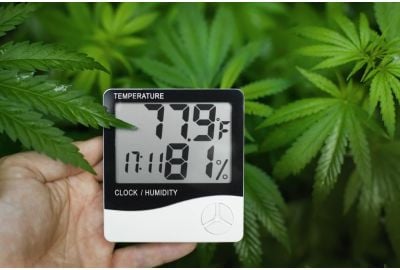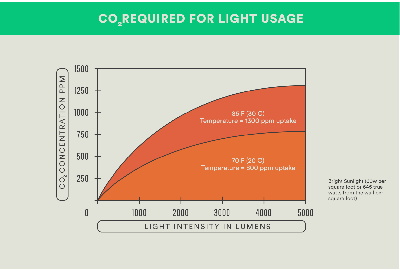CO2 for Cannabis: How to Increase Your Yields
Have you considered using CO2 for cannabis to improve the quality and quantity of your harvest? Did you know that carbon dioxide plays a vital role in plant development?
The odorless gas is readily available in the atmosphere, but supplementing your crops with it can do wonders for your final yield. This enrichment technique is for closed cultivation spaces, and there are various ways to use CO2 for indoor growing.
Below we discuss some of the pros and cons of using CO2 for marijuana. We also help you decide if it's viable for your unique growing circumstances.
If you want to know more about using this natural gas, you've come to the right place. Our comprehensive guide provides valuable information to implement this technique in your marijuana garden. Let's get started by understanding the role of CO2 in cannabis.
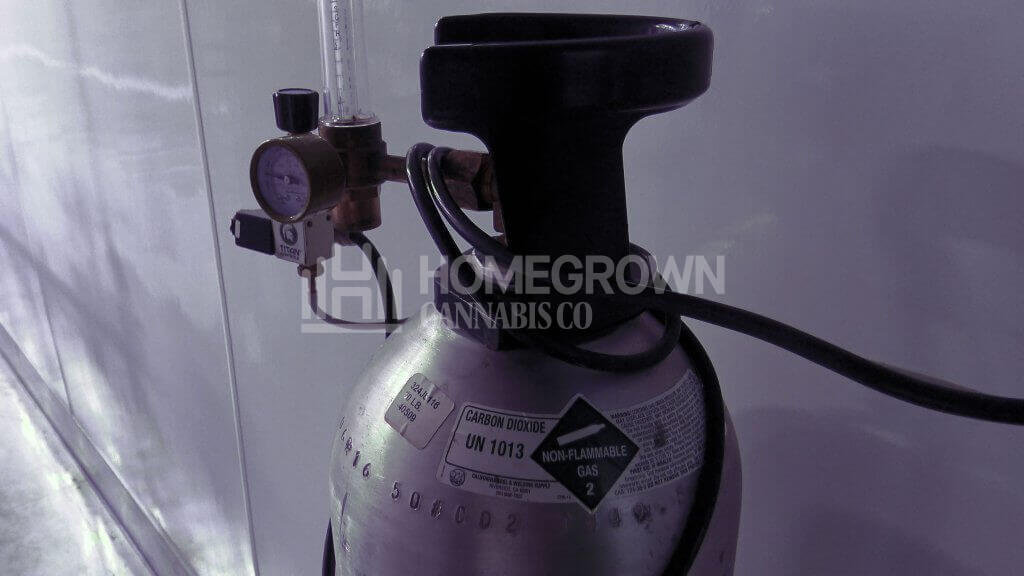
What does CO2 do for marijuana plants
CO2 plays a major role in the healthy growth of the plant. Together with water and sunlight, carbon dioxide is essential for crops to create sugars and oxygen. They ingest the substance through tiny pores on their foliage called stomata.
Marijuana plants and CO2 have a delicate relationship. While they need the gas to develop optimally, an excess could ruin the crops and damage the buds before they're mature enough to harvest.
Carbon Dioxide plays a role in three major life processes of the plant.
- Photosynthesis
- Transpiration
- Respiration
Photosynthesis
The process of photosynthesis is essential to all plants. Combining water, sunlight, and CO2 in marijuana crops produces glucose (sugars) and oxygen.
Transpiration
The way water travels through plants is called transpiration. The more moisture a crop loses, the less nourished it is.
So how does using CO2 for cannabis help? By minimizing how much water escapes. The stomata open wide when they lack carbon dioxide, which leads to evaporation. Introducing higher quantities of natural gas means these pores only need to open a little.
The lower the transpiration rate, the more hydrated the plant is. Subsequently, nutrients get distributed efficiently when there’s enough CO2 for marijuana.
Respiration
Respiration falls into two categories:
- Photorespiration
- Dark respiration
Photorespiration
The process of photorespiration helps dispel excess energy that the plant produces. Photorespiration decreases CO2’s efficiency, so providing supplements is useful.
Dark respiration
When there’s no light, photosynthesis can’t take place. Crops use the sugars produced in the day (with photosynthesis) and oxygen for energy. During this time, they emit carbon dioxide. Therefore, it’s essential to turn off the CO2 for cannabis in your grow area during the dark cycle.
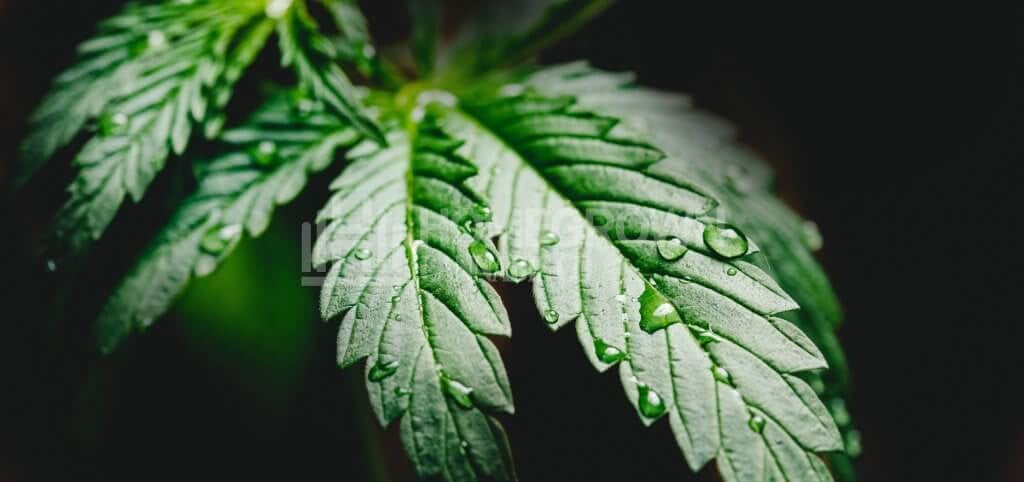
Pros and cons of CO2 for cannabis
When you introduce new techniques, tools, or supplements into your growing environment, there are benefits and drawbacks you need to weigh. CO2 for marijuana is no different.
Each environmental aspect that plays a role in improving or restricting the size of the yields is a limiting factor. The advantages and disadvantages of CO2 for cannabis as we summarize these below.
| Pros | Cons |
| Faster healthy development: When all limiting growth factors are optimized, adding CO2 during the veg stage boosts growth. | Expensive: Using CO2 in a grow room is costly. You need to ensure the whole area is covered, and the initial outlay requires a substantial investment. |
| Bigger yields: In an ideal growing environment where photosynthesis takes place optimally and transpiration is minimized, buds develop better. The role of CO2 for cannabis ensures the stomata pores don’t have to open too wide, thereby keeping the plant hydrated. The result is more generous, quality yields. | Powerful lights required: For CO2 to positively impact your crops, you need to pair it with effective lighting. HPS, LEC/CMH, and LED options work best, as smaller products won’t complement the carbon dioxide to achieve the results you want. |
| Better temperature support: When there’s adequate CO2 for indoor plants, they become less sensitive to heat. When there’s a range of 1200–1500 PPM(Parts Per Million) of carbon dioxide, crops withstand temperatures of up to 95°F. This works well with powerful infrared lights or big LEDs that could otherwise scorch the foliage. | Grow area needs to be sealed: Sealing your grow room is another costly endeavor. There are two reasons for this. Firstly, keeping this CO2 for cannabis from leaking, and secondly, maintaining the PPM levels in the grow area. |
| Smell reduction: Using certain CO2 cannabis growing methods requires special equipment like a carbon dioxide generator or carbon filters for grow room setups. These help hide the cannabis smell and facilitate discreet cultivation. | All other growing factors must be optimized first: The biggest challenge with incorporating CO2 for cannabis in your garden is ensuring that all your other growing techniques are in order. If any limiting factor is below standard, using carbon dioxide for enrichment won’t benefit your crops. The main aspect is lights, but nutrients, water, and training can also affect the outcome. |
| Security: When setting up a grow area with CO2 for marijuana, you need to seal off the space. While many view this as a negative aspect, it has a spillover advantage. Your crops are automatically better protected from thieves and animals. |
Should you use CO2 for marijuana plants?
The answer depends on where you are in your cultivation journey. Beginners who only have a micro grow setup or a small grow area with a few plants won't reap equal rewards for the time and effort implementing CO2 for cannabis takes.
The method is worth considering if you've got the basics of marijuana cultivation down to an art. If you want to improve your growing skills and reap healthy, dense buds as a reward, then you should give the technique a shot.
Before you invest in a carbon dioxide setup, first ensure the following are in order:
- Your garden is healthy and pest-free.
- There are no signs of pathogens or disease.
- You're using top-quality soil, nutrients, seeds, and other gardening necessities.
- You have an adequate light system in place.
- Your growing area is hygenic
- You have a healthy feeding routine, and the grow medium is the correct pH.
- You have a secure, sealable growing area.
If all these factors are in place, using CO2 for cannabis enrichment is ideal. If your growth area isn't ideal yet, optimize the other factors first.
Knowing whether or not to splurge on CO2 for marijuana crops financially is tricky. You need to be sure that there'll be a return on your investment. Using carbon dioxide for enrichment is best when:
- You already have powerful grow lights and some of the light wastes due to suboptimal CO2 levels.
- Your indoor marijuana garden has high temperatures exceeding 85℉.
- Seal the grow area, and as a result, you can maintain the gas levels.
- You’ve identified CO2 for cannabis as your current limiting factor.
Before introducing the gas, ensure that you have efficient temperature control and humidity setup. Make changes to improve the other factors and automatically enhance your plants' health. Once these are in order, introduce CO2 for marijuana crops.
When to use CO2 in grow room
A marijuana plant has four phases of maturity. During the germination and seedling phase, avoid supplementing with CO2. Once these crops perform photosynthesis, you can start introducing the gas.
Ideally, use CO2 for cannabis during the vegetative and flowering stages.
Vegetative stage
During this development phase, the plant starts using water, sunlight, and CO2 for cannabis to photosynthesize. It’s the stage where the crop develops the most and needs additional nutrients, care, and training.
The vegetative stage is crucial for producing healthy, quality buds, many growers opt to extend this phase to improve their yield. When you introduce CO2 during veg, it allows the crops to grow stronger and faster.
Growing marijuana with CO2 often means you don’t need to support the branches as they have enough strength. The buds are also typically healthier and denser.

Flowering stage
Do you want to know how to make buds bigger during flowering? Add a dose of carbon dioxide.
While growers agree that you must maintain the CO2 levels during flowering, they disagree about the duration. Some insist on limiting the supplementation to the early weeks only. Others use natural gas right up to two weeks before harvest.
How much does CO2 increase yield?
One of the main goals of cultivating marijuana is producing massive yields of exceptional quality. Using CO2 for indoor growing helps you achieve this. Some growers report up to a 20% increase.
It's important to understand that carbon dioxide isn't a stand-alone factor. Other environmental conditions play a vital role in producing fat, potent buds.
Aspects like strain genetics, grow medium, and training techniques all influence exactly how much the yield increases. If any other factors aren’t employed effectively, providing your marijuana with CO2 won’t make much of a difference.
CO2 vs. no CO2 growth
Using CO2 in your grow area accelerates the growth of your plants. It optimizes the three main life processes and allows the plant to develop quicker during the vegetative stage.
If you don’t use CO2 for cannabis cultivation, you can still produce successful yields, but you may notice quality and quantity differences.
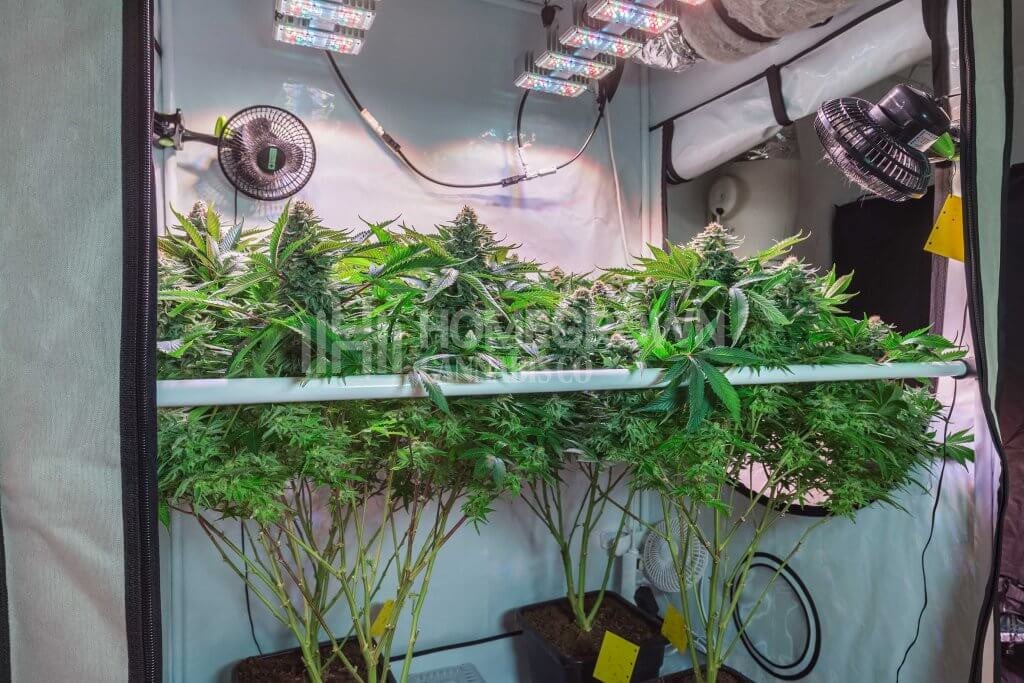
How much CO2 is needed
The ideal amount of CO2 for cannabis varies according to the type of lights you use. The range is 400–1500PPM. Anything above 2000 PPM is harmful to both the grower and crops. The table below displays the appropriate quantities of CO2 in relation to the light intensity measured in lumens per square meter (lux).
| Light intensity in lux | Appropriate CO2 PPM |
| 200–450 | 400 |
| 400–800 | 800 |
| 800–1000 | 1200–1400 |
| 1000–1400 | 1400–1500 |
How to add CO2 to your cannabis plants?
You have multiple options when you decide to incorporate CO2 for indoor growing. The three most common choices are generators, tanks, and bottled CO2. There are also alternative methods that are more organic but not necessarily as effective.
Each of these has advantages and disadvantages. Some are suitable for a grow tent setup, whereas others require a larger growing area to work effectively. Let’s take a closer look at each option.
CO2 generators
Using a carbon dioxide generator to provide CO2 for cannabis crops is straightforward. These tools have an integrated timer for automated use. They burn natural gas (propane) and turn it off when they reach the ideal PPM levels.
This method is suited to larger grow areas as the machine produces heat and carbon monoxide. We don’t recommend this for use inside the home as it can be dangerous.
Compressed CO2 tanks
Many domestic growers claim that these tanks are ideal for providing CO2 for cannabis in smaller spaces. They don't produce heat but require some elbow grease to use. You can also purchase special equipment to automate use.
This method is simple to apply, and you can control the PPM levels with a regulator.
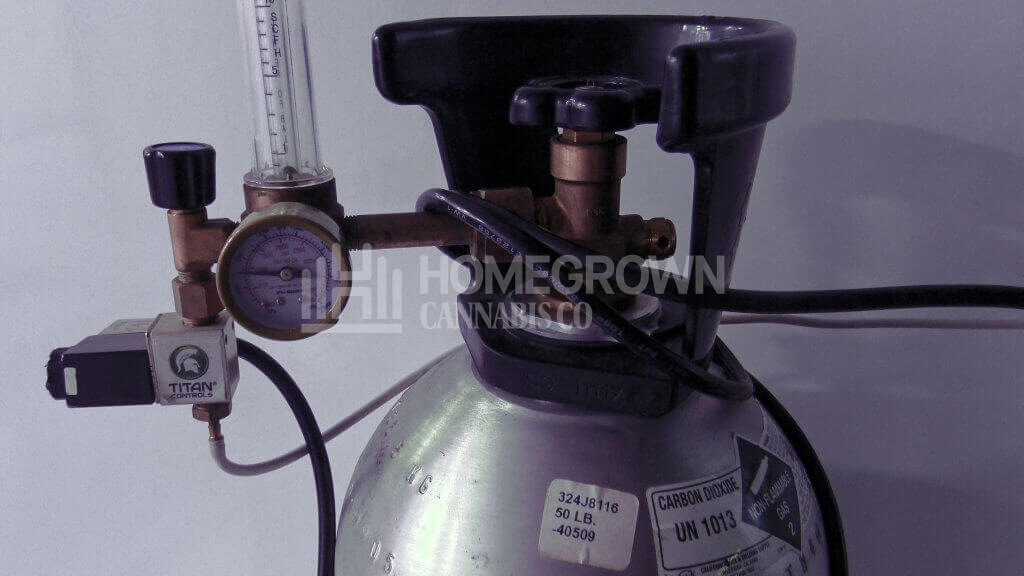
Bottled CO2
Bottled CO2 is a great one-off option. These products are easy to use and offer a slow release of natural gas into your grow area. It provides CO2 for cannabis that lasts 5–7 days before replacing it.
Compost
In small grow areas, adding compost to the soil produces CO2 for marijuana. It’s organic and doesn’t pose a safety hazard, but it can attract bugs or mold into your garden.
CO2 bags
This option of introducing CO2 to your marijuana crops is best suited to intermediate and advanced growers. They typically contain fungi and organic matter that produce natural gas. The ideal quantity is four bags for every 2m2.
Dry ice
Dry ice is the solid form of carbon dioxide. It’s a great short-term option but can get pricey when used over extended periods.
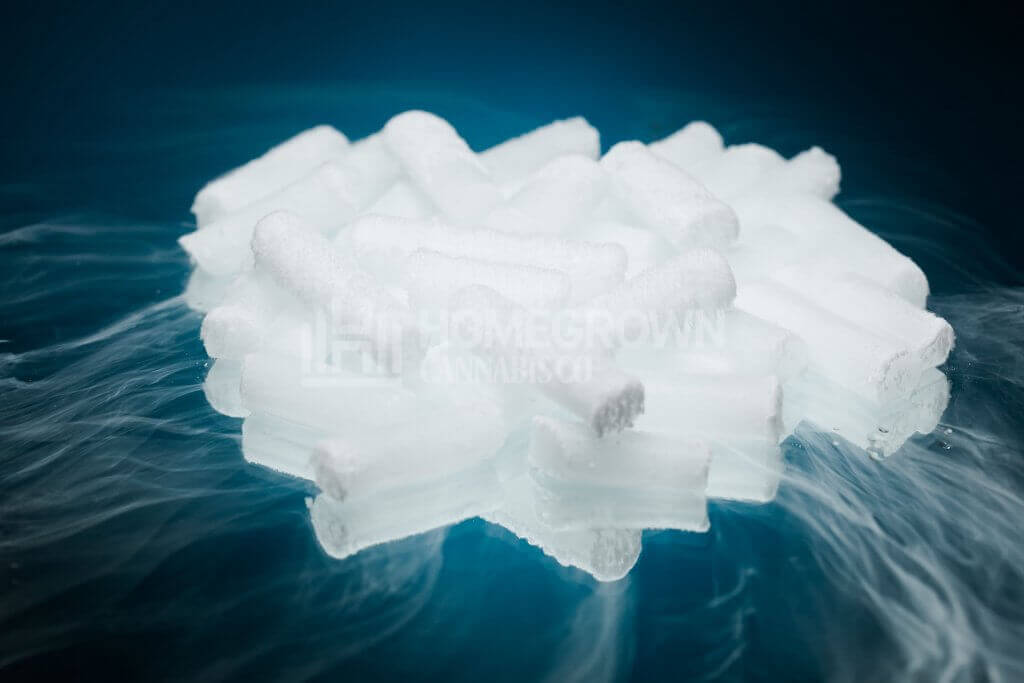
Homemade CO2
If you’re cultivating cannabis on a small scale, you can mix a homemade baking soda and vinegar solution to increase the marijuana CO2 levels.
Implementation tips
Once you’ve decided which route to take regarding CO2 in your grow room, there are several hints to help you take full advantage of the setup.
Inject the correct quantity
Depending on the size of your grow room and lights, the amount of CO2 varies. When you inject CO2 for cannabis cultivation, the temperature and light exposure must also increase.
Adding too much natural gas without changing the other factors can negatively impact your crops. Some leaves may turn yellow or droop.
Keep it sealed
Investing in CO2 for growing marijuana can be costly. To ensure there’s an appropriate return, seal your garden completely. Regular air only contains carbon dioxide of roughly 400 PPM. If it were to mix with your CO2 for cannabis, it would dilute it.
Use a top-down approach
CO2 is heavier than most atmospheric gasses and sinks quickly. Ensure that all your plants benefit from the exposure to the gas by locating your marijuana CO2 higher than the crops.
Another way to lift the gas is by using a fan to keep the air flowing throughout the room. The best approach is to let it rain down from above.
Only provide CO2 during the light cycle
Once your CO2 for marijuana cultivation is in place, employ a strict schedule that aligns with your lighting. During the dark cycle, the plants absorb oxygen through the roots and excrete carbon dioxide. Providing additional CO2 during this phase is wasteful.
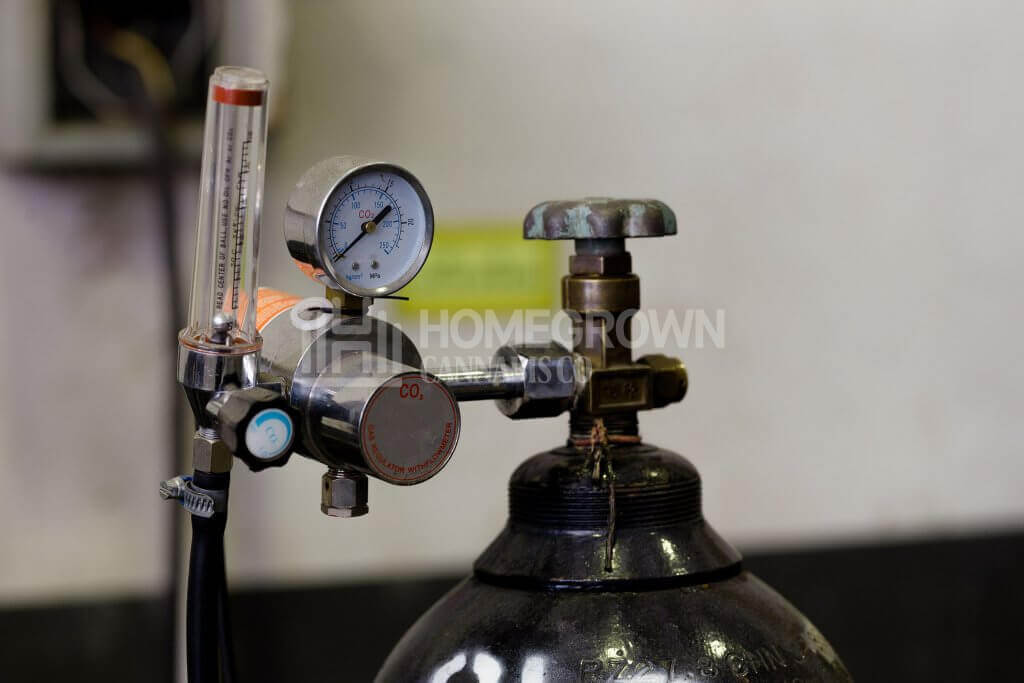
CO2—a breath of fresh air for cannabis
Using CO2 for marijuana cultivation has multiple benefits. If the expense isn't an issue, it can enhance the growing experience. Ensure that all other limiting factors are efficient and that your plants are well cared for.
Adding CO2 for marijuana crops to an immaculate grow area only improves the situation. Plants grow quicker, foliage is luscious, and the overall structure is strong and healthy. The buds from such crops are dense and potent, and the harvest is bountiful.
Why not use this natural gas to enrich your cannabis? Check out Homegrown Cannabis Co. and find the ideal strain to pair with your cultivation setup. Share this article with friends and follow us on social media for more tips on helping your marijuana garden thrive.
About the author: Derek LaRose
Also known as Kronic from The Cannabis Kronicles, Derek LaRose is a young ambitious cultivator and a staple educator for indoor cultivation.
